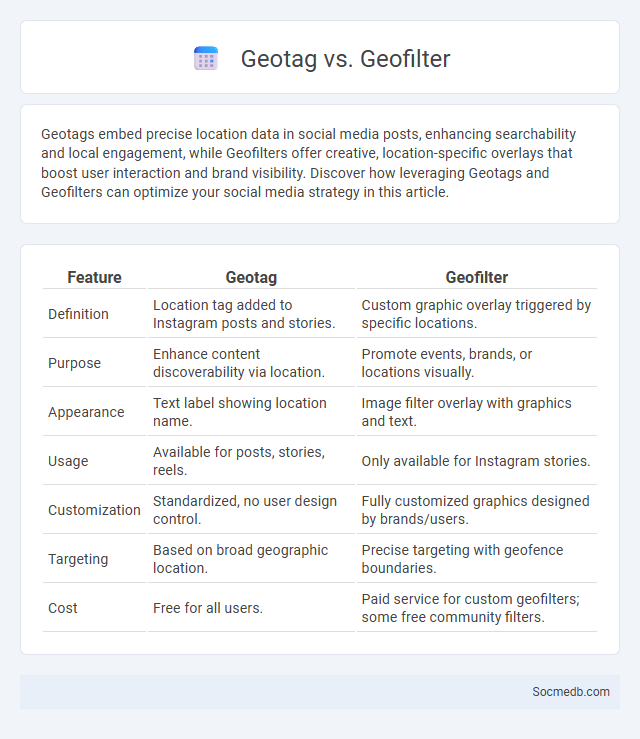
Photo illustration: Geotag vs Geofilter
Geotags embed precise location data in social media posts, enhancing searchability and local engagement, while Geofilters offer creative, location-specific overlays that boost user interaction and brand visibility. Discover how leveraging Geotags and Geofilters can optimize your social media strategy in this article.
Table of Comparison
| Feature | Geotag | Geofilter |
|---|---|---|
| Definition | Location tag added to Instagram posts and stories. | Custom graphic overlay triggered by specific locations. |
| Purpose | Enhance content discoverability via location. | Promote events, brands, or locations visually. |
| Appearance | Text label showing location name. | Image filter overlay with graphics and text. |
| Usage | Available for posts, stories, reels. | Only available for Instagram stories. |
| Customization | Standardized, no user design control. | Fully customized graphics designed by brands/users. |
| Targeting | Based on broad geographic location. | Precise targeting with geofence boundaries. |
| Cost | Free for all users. | Paid service for custom geofilters; some free community filters. |
Understanding Geotags: Definition and Purpose
Geotags are metadata embedded within social media posts that include geographical information such as latitude and longitude coordinates. These tags enable platforms like Instagram and Twitter to associate content with specific locations, improving searchability and relevance for local audiences. Understanding geotags helps you enhance your social media strategy by targeting location-based engagement and reaching users interested in your area.
What is a Geofilter? Key Features Explained
A Geofilter is a location-based digital overlay available on social media platforms like Snapchat and Instagram, designed to enhance your photos and videos with creative graphics tied to specific geographic areas. Key features include customizable designs, real-time location targeting, and time-specific availability, allowing businesses and individuals to promote events, landmarks, or local culture effectively. Your social media content gains unique visual appeal and local relevance, boosting engagement and brand visibility through these targeted, interactive filters.
Geotag vs Geofilter: Core Differences
Geotags are specific location markers attached to your social media posts, providing precise geographic coordinates that increase local searchability and audience targeting. Geofilters, on the other hand, are custom-designed overlays available within a defined geographic area, enhancing your content's visual appeal and engagement by allowing viewers to interact with location-based branding or themes. Your strategic use of geotags boosts discoverability, while geofilters create unique, shareable experiences tied to specific places or events.
How Geotags Work in Social Media
Geotags in social media attach precise location data to your posts, enhancing local discoverability and engagement by associating content with specific places. These location markers, embedded via GPS coordinates or manually chosen points on maps, allow platforms like Instagram, Facebook, and Twitter to categorize and display posts based on geography. By using geotags strategically, you boost visibility within targeted communities and attract audiences interested in particular locations or events.
Geofilters in Marketing: Practical Applications
Geofilters in marketing leverage location-based social media overlays to target specific audiences, driving brand engagement through personalized and contextually relevant content. Businesses use geofilters to enhance event visibility, promote local store visits, and increase user-generated content by encouraging customers to share branded experiences within designated geographic areas. This strategy boosts real-time interaction and amplifies brand presence in high-foot-traffic locations, making geofilters a powerful tool for hyperlocal marketing campaigns.
Benefits of Using Geotags for Businesses
Using geotags on social media significantly boosts your business's local visibility by connecting posts to specific locations, attracting nearby customers who are more likely to engage and visit. Geotags enhance user-generated content discovery, increasing brand authenticity and trust through real-time customer experiences. Businesses leveraging geotagging gain valuable insights into customer demographics and behaviors, optimizing targeted marketing strategies and improving ROI.
Creative Uses of Geofilters for Brand Engagement
Creative uses of geofilters for brand engagement include location-specific promotions that increase local foot traffic and events by encouraging user-generated content linked to the brand. Custom geofilters tailored to seasonal campaigns or product launches enhance brand visibility and foster community interaction by allowing users to personalize their snaps with branded overlays. Strategic placement of geofilters in high-traffic areas or during targeted times drives authentic engagement and boosts social sharing, resulting in higher brand recall and customer loyalty.
Privacy Concerns: Geotagging vs Geofiltering
Geotagging embeds precise location data in your social media posts, increasing the risk of privacy breaches by revealing your exact whereabouts to unintended audiences. Geofiltering, on the other hand, applies location-based overlays without sharing specific GPS coordinates, offering a safer way to engage with local content while maintaining greater privacy. Understanding the differences between geotagging and geofiltering helps you make informed decisions about sharing your location securely on social media platforms.
Choosing Between Geotag and Geofilter: When and Why
Choosing between a geotag and a geofilter depends on your goal and desired audience engagement on social media platforms like Instagram and Snapchat. Geotags provide location-specific information that enhances discoverability for users searching nearby, while geofilters offer creative overlays that boost visual appeal and brand recognition during special events or promotions. Understanding your campaign's purpose helps you decide which tool maximizes your content's impact and connects with your target audience effectively.
Future Trends: Geotags, Geofilters, and Location-Based Tech
Geotags, geofilters, and location-based technology are revolutionizing social media by enhancing personalized user experiences and driving targeted advertising. Platforms like Instagram, Snapchat, and TikTok increasingly integrate these features to enable real-time location sharing, interactive filters, and geo-specific content discovery. The future of social media lies in leveraging advanced location analytics and augmented reality to create immersive, context-aware digital environments that boost engagement and local business visibility.
 socmedb.com
socmedb.com